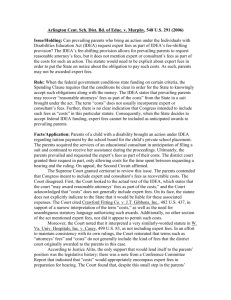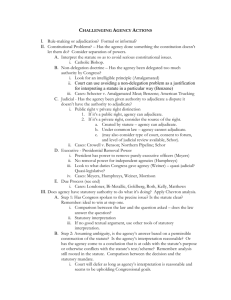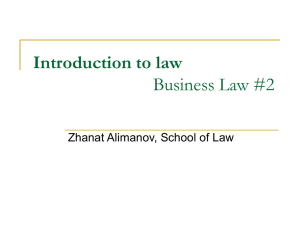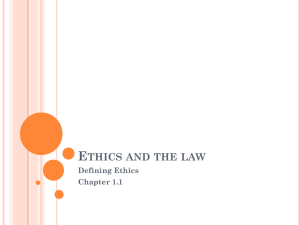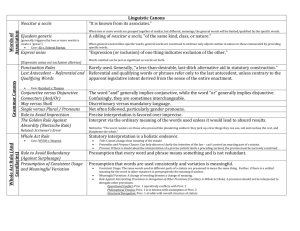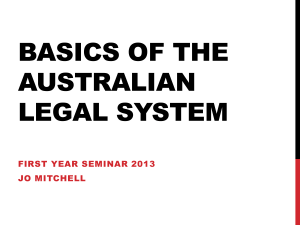How to Read a Statute: MAP It!
advertisement
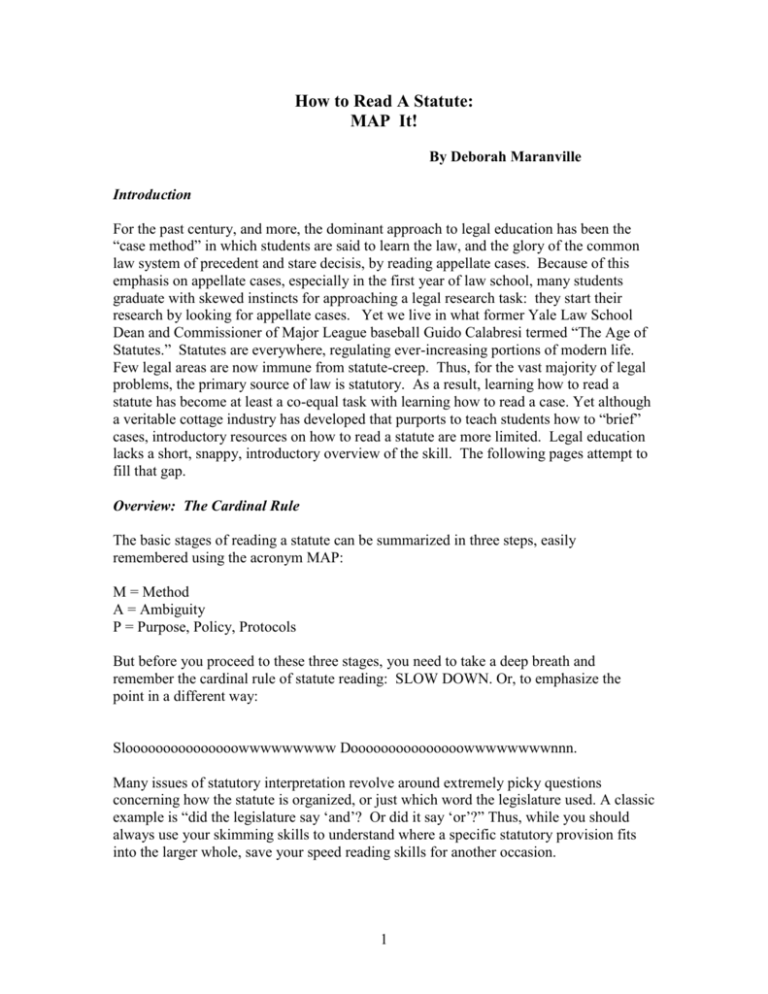
How to Read A Statute: MAP It! By Deborah Maranville Introduction For the past century, and more, the dominant approach to legal education has been the “case method” in which students are said to learn the law, and the glory of the common law system of precedent and stare decisis, by reading appellate cases. Because of this emphasis on appellate cases, especially in the first year of law school, many students graduate with skewed instincts for approaching a legal research task: they start their research by looking for appellate cases. Yet we live in what former Yale Law School Dean and Commissioner of Major League baseball Guido Calabresi termed “The Age of Statutes.” Statutes are everywhere, regulating ever-increasing portions of modern life. Few legal areas are now immune from statute-creep. Thus, for the vast majority of legal problems, the primary source of law is statutory. As a result, learning how to read a statute has become at least a co-equal task with learning how to read a case. Yet although a veritable cottage industry has developed that purports to teach students how to “brief” cases, introductory resources on how to read a statute are more limited. Legal education lacks a short, snappy, introductory overview of the skill. The following pages attempt to fill that gap. Overview: The Cardinal Rule The basic stages of reading a statute can be summarized in three steps, easily remembered using the acronym MAP: M = Method A = Ambiguity P = Purpose, Policy, Protocols But before you proceed to these three stages, you need to take a deep breath and remember the cardinal rule of statute reading: SLOW DOWN. Or, to emphasize the point in a different way: Slooooooooooooooowwwwwwwww Dooooooooooooooowwwwwwwwnnn. Many issues of statutory interpretation revolve around extremely picky questions concerning how the statute is organized, or just which word the legislature used. A classic example is “did the legislature say ‘and’? Or did it say ‘or’?” Thus, while you should always use your skimming skills to understand where a specific statutory provision fits into the larger whole, save your speed reading skills for another occasion. 1 Method The first step in reading a statute (that is, the first step in actually studying the statute, after you breathe, and after you skim the provisions surrounding the statute you will study in detail, to see how the specific provision fits into the larger whole), is Method. Identify the structure of the statute, and break it into pieces, methodically, step by step. If you are lucky, you will have one or more professor in the first year who will goes through this process with you in detail and demonstrate his or her own method for reading a statute. Approaches to statute reading vary, just as approaches to briefing cases vary. Some people try to break the statute into “elements,” the key activities that together will trigger a particular legal result. Others use an “If . . . then” structure, for the same purpose: identify the “if’s”, the predicates that trigger the statutory “then’s”. A third approach is to diagram the statute much as English grammar teachers sometimes teach students to diagram sentences (or used to!), identifying especially the subjects and verbs, scrutinizing the conjunctions (and, or), and the modifiers with care. Any method is fine, if it gets you pulling the statute apart in a way that you can understand it accurately. Additional Sources: Linda Holdemann Edwards, Legal Writing: Process, Analysis and Organization (3rd ed. 2002), Chapters 2 and 3 (analysis applies to judicially created rules, as well as statutes; the example is the ABA model code of professional responsibility, which is structured similarly to many statutes) Deborah A. Schmedemann and Christina L. Kunz, Synthesis: Legal Reading, Reasoning, and Writing (1999), Ch. 5, Reading a Statute, especially pp. 56-63 William P. Statsky, Legislative Analysis and Drafting (2d ed. 1975), Ch. 4, Elements, Issues, and Memos Ambiguity Many lawsuits involve a dispute over the meaning of a statute. Typically these disputes arise either because the language of the statute is ambiguous in some way, or because the result reached through a literal application of the statute seems absurd, or inconsistent with what the legislature seems to have intended. Thus, in reading statutes the second step is to look for the ambiguities. Did the legislature use what might be uncharitably termed “weasel words”, that is words like “reasonable” or “substantial” that will predictably generate disagreement over their meaning? Is the statute grammatically ambiguous, perhaps because it is not clear what word a phrase modifies? For instance, in the Florida election cases from 2000, a significant question was how to interpret a statute that provided: “If [a] manual recount indicates an error in the vote tabulation which could affect the outcome of the election, the county canvassing board shall . . ..” Was the statute directed at all errors in the vote tabulation, because any errors might affect the 2 outcome? Or was it aimed at limiting relief to a limited subset of errors so significant that the outcome could predictably be affected.1 Predicting when a court will find a statute to be ambiguous takes both experience and good judgment. As you read cases, be alert to the arguments parties make about when statutes are ambiguous, and how the courts respond, so you can hone your skills in this area. Protocols: Plain Meaning, Precedent, Purpose, Policy, etc. The third step in reading statutes is to learn the “protocols,” or “codes of correct conduct” that courts use in resolving ambiguities in statutes. Entire books are written on this subject, entire courses taught on it, and within the legal profession, we lack agreement on which approaches are “correct” or permissible. Thus, any brief introduction will inevitably oversimplify. The United States Supreme Court is divided as to which “protocols” are legitimate, but most advocates and lower courts will draw on all of them, as they seem useful. At this stage, you should become familiar with the following protocols, and the sources relied on by followers of each approach. Protocol: The plain meaning rule (also known as “textualism”). Sometimes a court will simply announce, by fiat, that no ambiguity exists, and claim that the “plain meaning” of the statute, typically using dictionary definitions, is unambiguous. (This can be amusing in a case that reaches the U.S. Supreme Court, where the court splits 5-4 and reverses the lower courts.) Justice Scalia is particularly fond of this protocol. Sources: Dictionaries and Canons of Construction. In arguing “plain meaning,” lawyers often resort to rules of interpretation, known as canons of construction, that are usually referred to by their Latin names. A widely used example is expression unius est exclusio alterius. (The expression of one specific thing is the exclusion of another.) Karl Llewellyn, the famous legal realist theorist of the mid-twentieth century, argued that these canons are indeterminate, because they come in matched and contradictory pairs.2 Protocol: Legislative Intent (also known as “originalism”). A second approach is to interpret the statute in the fashion that will best further the intent of the legislature. In trying to determine the intent of the legislature, a court will often look at the legislative history of the statute. Source: Legislative History. What did the committees that drafted or considered the statute say in committee reports? What claims did supporters make in 1 The problem and the quoted language are taken from Alex Blashausser, From the Electoral College to Law School: Research and Writing Lessons From the Recount, PERSPECTIVES: TEACHING LEGAL RESEARCH AND WRITING (2001) 2 Karl Llewellyn, THE COMMON LAW TRADITION (App. C) 3 legislative hearings, or debate on the floor of the legislature, about how the statute should be interpreted? Protocol: Precedent. Sometimes, the court will interpret a statute in a particular way, because that’s the way it’s always been done. In other words, the court will rely on prior precedents. Sources: The cases in all those opinions you’re reading. Protocol: Purpose. Often the court will engage in “purposive reasoning,” trying to identify the purpose for the statute by asking, “What was the legislature trying to accomplish?” and “What interpretation will best further that purpose”? Sources: Historical context. What were the issues of the day when the legislature enacted the statute? What social problems was the legislature trying to address? Protocol: Policy (often relied on by proponents of “dynamic” interpretation). Courts (and law professors asking their students to be pretend-judges) often ask “Which interpretation will lead to the ‘better’ result?” with “better” being evaluated in light of “policies“, such as certainty or predictability, efficiency, or fairness. Sources: Current contexts and public values. In evaluating policy, the courts will look at the current social context and evolution of societal values. For instance, they might evaluate how social and technological changes have altered the way a statute operates in practice. Should statutes or rules that specify how a lawyer must deliver court papers to an opposing lawyer be read broadly to permit delivery by e-mail or FAX technology? Or would that require a new or amended statute or rule? Additional Source: Lon L. Fuller, The Case of the Speluncean Explorers, 62 Harv. L. Rev. 616 (1949)(Classic article using a case about cave explorers reduced to cannibalism to demonstrate how different jurisprudential approaches lead to different interpretations of a murder statute) 4


